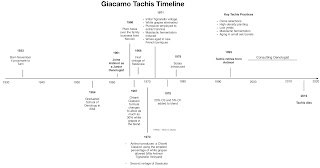He is said to have dragged Italian wine "kicking and screaming" into the 20th century by changing the style and the way the wines were perceived. According to Piero Antinori, he was "instrumental in the evolution, not only of Tuscan wines, but Italian wines." These words of praise from lofty wine perches were aimed at none other than Giacomo Tachis who drinksbusiness.com has referred to as "the father of Italian wine."
As shown in the timeline below, Giacomo was born on November 4, 1933 in the vicinity of Turin.
He graduated from the Alba School of Oenology in 1954 and took jobs first at a Sparkling Wine House and then a large distiller prior to being hired into the Antinori fold as a Junior Oenologist by Niccolò Antinori. Within a short space of time was promoted to Technical Director with responsibility for (i) expanding the winery's output and (ii) developing products that would meet the expectations of the world market. This was a tall order because wines from the region were not well regarded at that time. Wines were of poor quality due to :
- High-yielding Sangiovese clones
- Low-density planting
- Poor site selection
- Unhygienic cellar practices
- Old, dirty barrels.
Quality was further affected by an increase in the white grape contribution to the blend. Chianti Classico had historically been a blend of Sangiovese and Canaiola plus 5% of the Malvasia grape. In 1967 the formula was adjusted to allow up to 30% of the blend to be Malvasia and Trebbiano. This led to thin, watery wines lacking in structure and ageability.
Giacomo was a great admirer of the French Oenologist Emile Peynaud and had been working with him to understand his processes and to determine which elements could be implemented in Tuscany to resolve the wine quality issues. Peynaud had garnered fame due to his very successful efforts in cleaning up the Bordelaise wines. His practices included:
- Harvesting fully ripe grapes
- Accepting low acid levels in grapes and wine
- Controlled temperatures in the cellar, especially during fermentation
- Understanding and controlling malolactic fermentation
- Aging wine in clean oak barrels.
The plan was to use Peynaud's methods to clean up the Antinori wines but, before landing that plane, Giacomo was asked to assist Piero's uncle, Marchese Mario Incisa delle Rochetta, in taming the Cabernet Sauvignon wines from his Bolgheri estate. The Marchese had planted his Tenuta San Guido estate in Bolgheri in 1948 with cuttings sourced from the Bordeaux vineyard of Chateau Lafitte-Rothschild. The grapes had been faithfully fermented but the resulting wines were rather rustic. Incisa delle Rochertta reached out to Piero to have Antinori distribute the wines and he agreed to do so if Giacomo were named chief winemaker on the project. All parties were on board and the rest is history.
Tachis blended the 1966, 1967, and 1968 vintages and released 6000 bottles as Sassicaia 1968. That wine was an immediate and smashing success. Further, he added the 1970 crop to the blend for the 1970 vintage. That was also a success and the label has never looked back.
With the Sasicaia success under his belt, Tachis turned his full attention to the core project, fruit from the Tignanello vineyard. In 1970 Antinori released a Chianti Classico with the smallest percentage (5) of white wine allowed. This wine was called Chianti Classico Riserva Vigneto Tignanello. The initial Tignanello release occurred in 1971 and featured Sangiovese plus small percentages of other local varieties and aging in oak barriques.
The second vintage of Tignanello was released in 1975 and included the following modifications:
- All white grapes eliminated from the blend
- 20% Cabernet Sauvignon and 5% Cabernet Franc added to the Sangiovese backbone
- Pumpovers employed to facilitate tannin extraction
- Malolactic fermentation induced
- Wines aged in new French oak barriques.
The Peynaud influence was on full display in this vintage.
In 1978 Antinori released a Cab-based blend using grapes sourced from Solaia, Tignanello's sister vineyard. In this wine the Sangiovese and Cabernet Sauvignon percentages from Tignanello were switched. By this time Tachis had become so famous that his name on a project almost guaranteed commercial success.
Tachis retired from Antinori in 1993 -- a run of 32 years -- but continued to consult with the company on its Super Tuscans as well as with other companies on their initiatives.The below chart curates the labels with which Tachis has been associated during the course of his career.
Giacomo Tachis died in 2016.
©Wine -- Mise en abyme


No comments:
Post a Comment